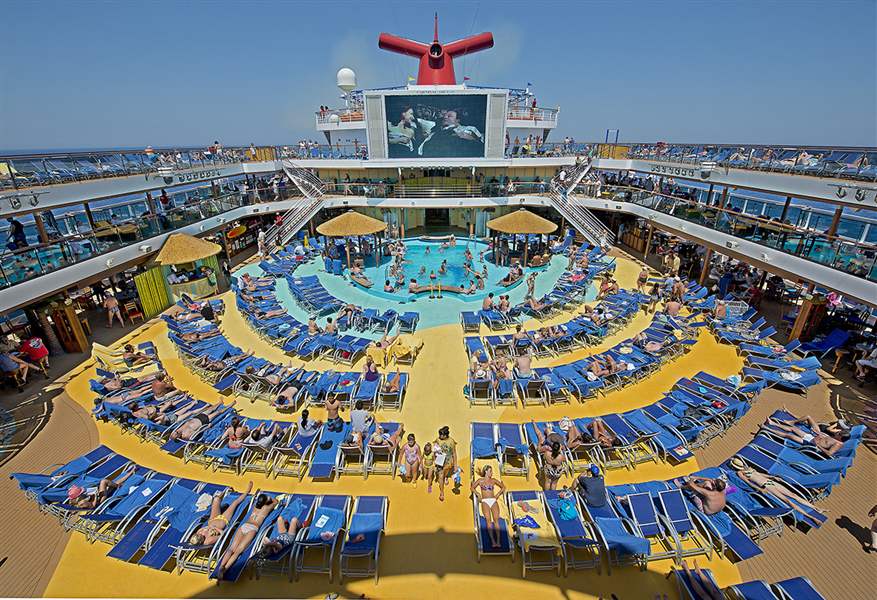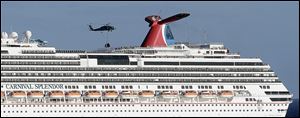
Cruise lines trying to get newcomers on board
Stereotypes, mishaps on ships make already-leery first-timers stick to land
3/30/2014
Vacationers aboard the Carnival Breeze sunbathe while viewing a movie on a 270-square-foot screen. Lines are looking for ways to lure the 200 million Americans who have never taken a cruise.
CARNIVAL CRUISE LINES

Vacationers aboard the Carnival Breeze sunbathe while viewing a movie on a 270-square-foot screen. Lines are looking for ways to lure the 200 million Americans who have never taken a cruise.
MIAMI — Cynthia Rodriguez has seen cruise ships around South Florida, watched commercials touting the option as a value, and heard stories from friends who have cruised.
But the 44-year-old North Bay Village resident has never set sail herself, unsure about what she’d do on a ship or how much the trip would actually cost. Lately, concerns about a spate of headline-grabbing incidents on cruise ships have added to her uncertainty.
“I’ve always considered it,” said Ms. Rodriguez, who works in bookkeeping. “I don’t know. I’m afraid I’d be stuck on there and kind of be bored.”
With multimillion-dollar ad campaigns, brand partnerships, travel agent help, and on-board innovation, cruise lines are desperately trying to woo newcomers such as Ms. Rodriguez and the more than 200 million other Americans who have never taken a cruise.
As thousands of players in the international cruise industry gathered in Miami Beach recently for the annual Cruise Shipping Miami conference to discuss trends in entertainment, dining, marketing, and itinerary development, one key issue remained central: How to get people to step aboard that first ship?
“Getting that first-timer is critically important to us,” said Dwain Wall, senior vice president overseeing agency and trade relations for the Cruise Lines International Association. “We know that the future is bright for us if we can get them on their first cruise — they will come back multiple, multiple times.”
According to CLIA, the greatest potential markets for first-time cruisers include the 95 million millennials, a group between the ages of 18 to 37 that accounts for $1.3 trillion in consumer spending; multigenerational families traveling together; social groups taking cruises around a shared interest, and river and specialty cruising.
There’s a huge pool to draw from. According to a report by CLIA in 2011, the most recent numbers available, only about 73 million people in America — by far the largest cruise market — had ever gone on a cruise, or 24 percent of the population. That was an increase from 2008, when 59 million [or 20 percent] had cruised.
The number of vacationers who choose a cruise continues to increase both in the United States and globally, where the passenger count is expected to rise from 21.3 million in 2013 to 21.7 million this year. But the percent of vacationers who have taken a cruise has remained relatively stable.
Executives and industry observers say that converting travelers who have stuck to land can be tricky for many reasons, including unfamiliarity, stereotypes, and, in the last couple of years, negative publicity surrounding cruise-related incidents.
“If you haven’t been on a ship, it’s very hard to imagine what it’s like,” said Carolyn Spencer Brown, editor in chief of CruiseCritic.com. “With a hotel or resort, you know what that is — everybody’s stayed in one. And you can go and stay in a resort, but you can leave if you want to.”

A Navy Seahawk helicopter prepares to drop supplies onto the Carnival Splendor during relief efforts off Mexico’s Baja Peninsula in this 2010 file photo.
Cruise lines, travel agents, and experts say that some of the main points of resistance are people’s concerns that they or their children will be bored; that they’ll be forced to stick to a strict eating and entertainment schedule; that they won’t get enough time at destinations, and that only retirees go on cruises. But while lines have invested billions of dollars in new ships brimming with activities, restaurants, and entertainment aimed at young travelers, that message is still not universally understood.
“From the standpoint of the consumer, the concern is that there’s too much risk of disappointment,” said Henry Harteveldt, travel industry analyst for consultancy Hudson Crossing.
For a noncruising public already on the fence, the last two years offered several reasons to stay on shore. In January, 2012, the deadly Costa Concordia shipwreck in Italy drew worldwide coverage. The next year, fires aboard the Carnival Triumph and Royal Caribbean International’s Grandeur of the Seas drew new coverage. Earlier this year, norovirus sickened about 700 people on a Royal Caribbean ship, forcing the company to end a trip early.
“The only thing missing is a real-life Poseidon adventure,” Mr. Harteveldt said. “It’s been a disaster for the industry.”
He added, “The concern that people have is: ‘If I’m going to spend a lot of money on a cruise and take a week or two of my valuable, hard-earned vacation, why would I want to do something that has even the slightest element of risk involved?”
The industry has addressed safety concerns. Carnival, for example, has devoted hundreds of millions of dollars to fleetwide fixes on safety, reliability, and fire-suppression systems. But there are other approaches too.
Carnival Cruise Lines introduced the “Great Vacation Guarantee,” which offers a 110 percent refund and free transportation home if guests want to leave within the first 24 hours of a cruise.
Jim Berra, Carnival’s chief marketing officer, said since the guarantee was introduced in September, about 40 people — out of about 2 million guests — have taken the line up on it, mostly because passengers needed to get home for a medical issue or forgot documents.
The largest lines, including Carnival, Royal Caribbean International, and Norwegian Cruise Line, all have designs on bringing more families in to grow first-time business — and relatively similar approaches. All three say that their new-to-cruise population makes up about a third of passengers a year or slightly more, in Carnival’s case.
All have sought partnerships with well-known brands as a familiar bridge to land-based comforts.
For instance, some Royal Caribbean International ships feature a Starbucks, DreamWorks entertainment, surfing machines, rock-climbing walls, and Broadway shows. The line’s newest ship, Quantum of the Seas, is to include a mechanical observation pod, a simulated skydiving experience, and bumper cars.